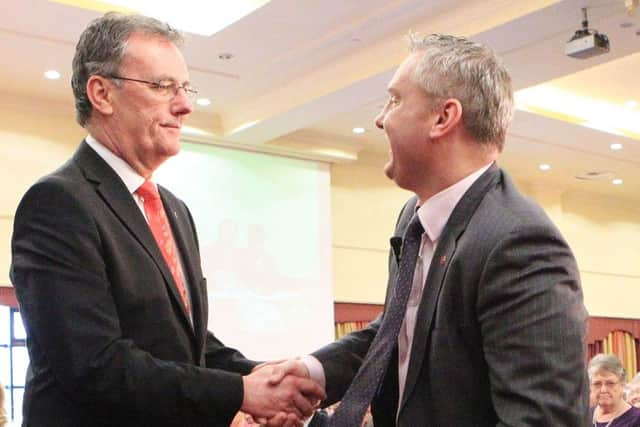Sam McBride: Nesbitt leaves UUP with the same ideological vacuum he inherited


Mike Nesbitt almost received the leadership by default due to the lack of other willing candidates and the UUP membership’s aversion to the liberal ideas of his opponent, John McCallister.
He was given the job largely because of his presentational abilities; a broadcaster confident in front of a camera was welcomed with open arms by a party which had long struggled to communicate its message.
Advertisement
Hide AdAdvertisement
Hide AdUnsurprisingly, though, with the focus from the start being on his ability to sell a message rather than the message itself, there was a philosophical vacuum from the beginning. That deficit continued throughout his leadership and the party has not resolved its existential question. It now faces exactly the same debate of five years ago – whether to head closer to the DUP and the path of traditional unionism, or a more liberal and accommodating pro-Union stance which would take it closer to the Alliance Party.


But that is not to say Mr Nesbitt did not make significant improvements in his time as leader. He attempted to present a positive vision for Northern Ireland’s future within the Union rather than simply focus on what is the slowly declining pool of Protestant voters from which the UUP has historically drawn its support.
The Strangford MLA overhauled many of the party’s structures to give the leadership more control – that will be crucial in assisting any future leader who does settle on a clear direction.
He also professionalised the party’s backroom operation, making changes in the press office and other key – but publicly unseen – areas.
Advertisement
Hide AdAdvertisement
Hide AdAnd, most importantly, he brought discipline to a party which was freewheeling towards implosion when he took over.


Without appearing Stalinist or undoing the UUP’s more open tradition, Mr Nesbitt managed to make clear to his members that they should not be shooting from the hip to every journalist they met.
But fundamentally Mr Nesbitt never plotted a clear course for Ulster Unionism. Early in his leadership, he joined the DUP in backing a unionist unity candidate in a Westminster by-election, then he entered a pact with the DUP two years ago for the General Election – part of which was to help the DUP unseat Alliance’s Naomi Long in East Belfast, and then last year he took the UUP into opposition to the DUP-Sinn Fein Executive at Stormont.
The logical outworking of the opposition move saw Mr Nesbitt take on the DUP in this election – but in so doing he found himself not only saying that he would transfer to the SDLP but saying that he would also transfer to Mrs Long. Unsurprisingly, many in his party were bamboozled by such radical shifts and questioned what he actually believed.
Advertisement
Hide AdAdvertisement
Hide AdHis latent liberalism must also have been questioned by some voters who had observed his earlier unionist unity argument just two years earlier.
Ironically, given where he subsequently has taken the party, it was the pact which brought Mr Nesbitt his most success, yielding one MP in Fermanagh-South Tyrone and (though not in the pact area) also seeing the UUP return as the Westminster representative of South Antrim.
It was quite a journey from a unionist pact to keep out Naomi Long (and Sinn Fein in other seats) to voting for the SDLP rather than the DUP.
I was sitting about four feet from Mr Nesbitt in a Broadcasting House studio when he made his critical comment of this election – that he would transfer to the SDLP before other unionists.
Advertisement
Hide AdAdvertisement
Hide AdIn some ways, it summed up Mr Nesbitt’s leadership of the UUP. Initially, he told presenter Mark Carruthers: “I will be transferring from my Ulster Unionist votes to the SDLP.”
That was a deliberate nod to the electorate and would have unsettled some UUP members, but it was not a wildly controversial statement as many unionists transfer to the SDLP far down on their ballot papers.
But, when Mr Carruthers asked him if that meant he would vote Ulster Unionist ‘1’ and then SDLP next, he said: “Yes.”
That one word was a momentous statement for an Ulster Unionist leader.
Advertisement
Hide AdAdvertisement
Hide AdWhether he realised its full significance or even meant to say it wasn’t clear to me at the time and has not been clarified since. What was clear very soon was that he had not discussed it with his candidates, who overwhelmingly came out to say they would be transferring to other unionists before anyone else.
It wasn’t the first time Mr Nesbitt said something which appeared to betray a superficial understanding of the party he led.
When interviewing him – and, unlike some other politicians, he always fronted up for interviews even when facing tough questioning – I was frequently struck by how freely he expressed opinions without apparently realising how controversial those might be within his party.
When it came to departing the stage, however, Mr Nesbitt showed not only dignity and leadership– but political nous.
Advertisement
Hide AdAdvertisement
Hide AdEarly in the count on Friday, it became clear that the UUP was not going to make gains. As the day went on, it was obvious that actually the party would lose numerous seats. As such, Mr Nesbitt’s position was untenable.
Rather than wait for the inevitable pressure to quit, Mr Nesbitt quickly decided to go – departing with good grace and without recrimination before the count had even finished.
That left some of his candidates in the tricky position of immediately being asked about a vacancy of which they were unaware.
But it immediately lanced a boil before it had begun to fester. In so doing – particularly after his clear statement that “the buck stops here” in the UUP – Mr Nesbitt turned the focus on to Arlene Foster.
The UUP that Mr Nesbitt led was more polished and more confident, but ultimately beset by an unanswered question it now must address: What does it stand for?